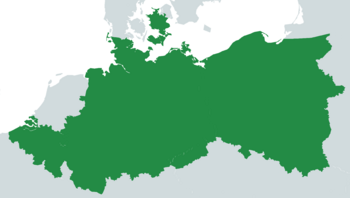Carrelie
This article is incomplete because it is pending further input from participants, or it is a work-in-progress by one author. Please comment on this article's talk page to share your input, comments and questions. Note: To contribute to this article, you may need to seek help from the author(s) of this page. |
Carrelian Empire Goswenous Canerila | |
|---|---|
Motto: 'Onfeïtebe Épaneit' Forever Infallible | |
Anthem: 'Ve Mase oú Canerila' Royal anthem: 'Ńoúte-Damme oú Canerila' | |
 Carrelie in Western Europe | |
| Capital | Densmouth |
| Largest city | Haufenburg |
| Official languages |
|
| Recognised regional languages |
|
| Demonym(s) | Carrelian |
| Government | Federal Parliamentary Semi-Constitutional Elective Monarchy |
• Empress | Ann II Ifynmarsh |
• Speaker of the Lords | King Leopold XII of Andlin |
• Speaker of the People | Ísan Saiseta |
| Legislature | Councils of Power |
| Lords Council | |
| House of the Peoples | |
| Formation | |
• Union of the Empire | 1 May 1570 |
• Federation | 1 February 1644 |
• Carrelian Civil War | 30 June 1861 - 4 June 1874 |
• Dentrician Revolution | 27 April 2013 |
| Population | |
• 2020 estimate | 754,187,200 (3rd) |
• 2012 census | 751,454,271 |
• Density | 270.7/km2 (701.1/sq mi) (50th) |
| GDP (PPP) | 2020 estimate |
• Total | 5,236,138 (4th) |
• Per capita | 61,816 (8th) |
| GDP (nominal) | 2020 estimate |
• Total | 3,780,553 (4th) |
• Per capita | 63,051 (5th) |
| Gini (2019) | 29.7 low |
| HDI (2019) | very high · 6th |
| Currency | Valire (₴) (VLR) |
| Time zone | UTC+0 - +2 (BGT, MCT, AMT) |
| Date format | dd/mm/yyyy (AD) |
| Driving side | left |
| Calling code | +49 |
| Internet TLD | .cn |
Carrelie, officially the Carrelian Empire, is a country in Europe. It borders the English Channel and the North Sea in the west and the Baltic Sea in the east. It is bordered by the Netherlands, Luxembourg and France to the west; Germany, Czechia and Slovakia to the south; Ukraine to the southeast and Lithuania and Belarus to the east.
Various tribes have inhabited the area now known as Carrelie since antiquity. The first recorded tribe to have inhabited the area is the Caisecawer, the direct ancestor of the modern Iffrws. The region was first united in the 970s, when Petty King Gosanric of Kuris conquered the Hasvet kingdoms neighbouring his domain, declaring himself High King. This kingdom collapsed after the death of Covrin the Unfortunate, only to be restored 23 years later by Count Edward Claes of Haufenburg in 1127. This line would later form the empire under Frederick the Victorious and stretch Carrelie to its current borders.
Today, Carrelie is a semi-constitutional federal elective monarchy. It is comprised of 12 autonomous nations, including 2 city-states. These nations are further divided into administrative divisions, such as Achanor's counties and Douria's lordships. Each of these nations are headed by their own head of state and head of government, with their own legislature. However, these legislatures all report to the Councils of Carrelie in Densmouth.
Etymology
Carrelie's English name comes from a misspelling of the nation's name in the 14th-century book Trade of Western Europe. When the manuscript was translated into English, the name for Carrelie in the book, the Land of Cornelian, a gemstone commonly traded in the area, was mistranslated as the Land of Carelian. When the guide became popular in England, the name Carelian fell into popular use, with the world later shortened to Carrelie

